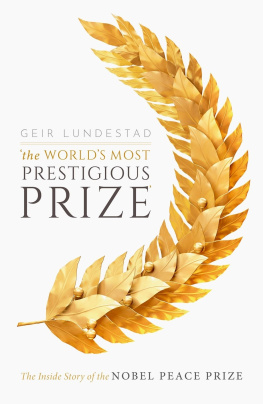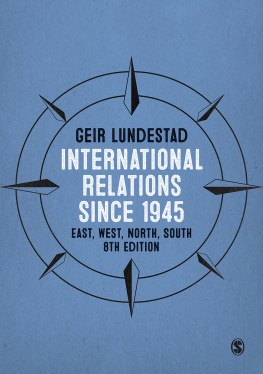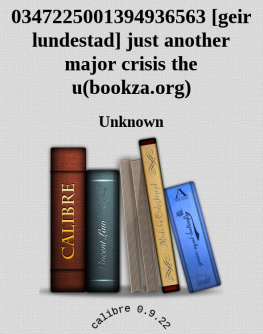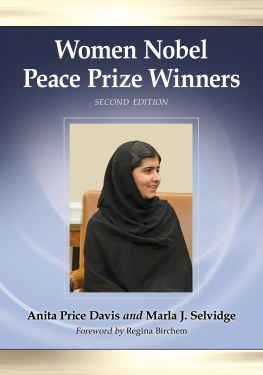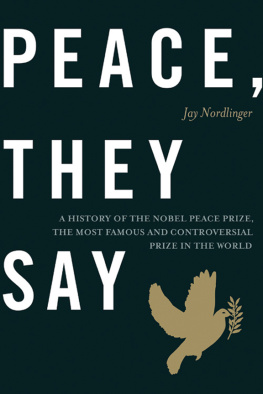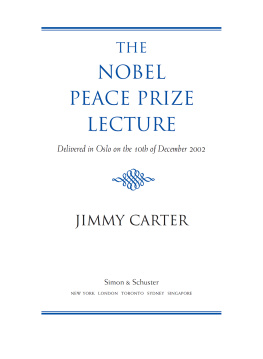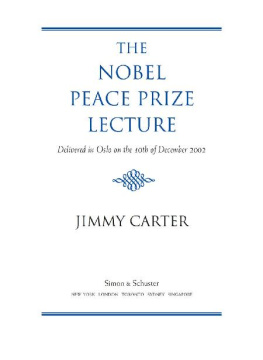THE WORLDS MOST PRESTIGIOUS PRIZE

Great Clarendon Street, Oxford, ox 2 6 dp , United Kingdom
Oxford University Press is a department of the University of Oxford. It furthers the Universitys objective of excellence in research, scholarship, and education by publishing worldwide. Oxford is a registered trade mark of Oxford University Press in the UK and in certain other countries
Geir Lundestad 2019
The moral rights of the author have been asserted
First Edition published in 2019
Impression: 1
All rights reserved. No part of this publication may be reproduced, stored in a retrieval system, or transmitted, in any form or by any means, without the prior permission in writing of Oxford University Press, or as expressly permitted by law, by licence or under terms agreed with the appropriate reprographics rights organization. Enquiries concerning reproduction outside the scope of the above should be sent to the Rights Department, Oxford University Press, at the address above
You must not circulate this work in any other form and you must impose this same condition on any acquirer
Published in the United States of America by Oxford University Press
198 Madison Avenue, New York, NY 10016, United States of America
British Library Cataloguing in Publication Data
Data available
Library of Congress Control Number: 2018968293
ISBN 9780198841876
ebook ISBN 9780192579027
Printed and bound in Great Britain by Clays Ltd, Elcograf S.p.A.
Preface
For twenty-five years, from 1 January 1990 to 31 December 2014, I was the Director of the Norwegian Nobel Institute and the Secretary of the Norwegian Nobel Committee. The committee, which has five members selected by the Norwegian Parliament (Storting), is responsible for awarding the Nobel Peace Prize, and the Institute is in many ways the secretariat of the committee. I enjoyed my job a great deal. That is why I chose to stay for such a long period of time.
The contact with the Peace Prize laureates was certainly the most stimulating part of my job. During my twenty-five years I met virtually all of them. I played an important role in the entire selection process, from the submission of all the many nominations for the Peace Prize, to the detailed evaluations of the most relevant names for each year, to the award ceremony on 10 December each year. During the Nobel days in December I followed in the wake of practically every step the laureates took.
The laureates were very different. Some of them belonged on the political left, somewhat fewer on the political right. However, most of them had two things in common. They had a vision of what they wanted to achieve in their lives, and most of them had shown considerable political courage in trying to make that vision a reality. Some of them faced the most difficult of circumstances. A few were not even able to come to Oslo to receive their awards.
After I left office in 2014, I wrote two books in Norwegian about the Nobel Peace Prize. The first one, Fredens Sekretr. 25 r med Nobelprisen (The Secretary of Peace. 25 Years with the Nobel Prize; 2015), received a great deal of attention and became a bestseller in Norway. The second, Drmmen om fred p jord. Nobels fredspris fra 1901 til i dag (The Dream about Peace on Earth. The Nobel Peace Prize from 1901 to Today; 2017), was more academic in nature and drew less on my own personal experiences.
This book in English draws on both these Norwegian volumes. The historical sections are primarily derived from the second. These parts are based on documents in the historical archives available in the library of the Norwegian Nobel Institute and on literature written by both historians and participants in the process, be they former committee members or the laureates themselves. The sections on the years from 1990 up to the present are derived from Fredens Sekretr.
As the Nobel Peace Prize has received more and more attention, many books and articles have been published about aspects of its history. Although some of these have presented useful details about the committees work, this volume is the first real insider account of the work of the Nobel Committee. The statutes of the Nobel Foundation, which regulate the work of all the Nobel committees and all the Nobel prizes, state that the varying opinions of the committee members should not be revealed. Therefore, even in this book the views of individual committee members will not be spelled out. In most other respects I have tried to be as open as possible. The Nobel Peace Prize plays a role, however limited, in international politics in todays world. It is important that the information about the prize be as complete and as credible as possible. It is my hope that this book will represent a step forward in that respect.
I would like to thank Sin Mackie for translating the book into English, and literary agent Hans Petter Bakketeig for his work to secure other translations. Dominic Byatt, Publisher in Social Science and Humanities at Oxford University Press, has supported my work for many, many years. Celine Louasli and Sethuraman Lakshmanan at OUP, along with freelancer Joshua Hey, were most professional in transforming the manuscript into book form. I would also like to thank Bjrn Helge Vangen and Marte Salvesen at the Nobel Institute library for their technical assistance.
My wife Aase, our sons Erik and Helge, and our grandchildren Jrgen, Oscar, Alfred, Helmer, Sebastian, and Ferdinand have provided the enthusiasm which is necessary for a retired academic to continue his work even in formal retirement.
Geir Lundestad
Oslo, February 2019
Contents
On the first or second Friday of October, the chair of the Norwegian Nobel Committee, flanked by the secretary, approaches a microphone and announces who will receive that years Peace Prize. The Grand Hall at the Nobel Institute is full of journalists from all over the world. As soon as the laureates name is announced, leading politicians and journalists start commenting on the Nobel Committees decision. Some will say it was a good decision, others will wonder what the committee was thinking. However, what is striking is just how interested the world is in what the committee decides.
Why does the world care about the decision of a committee of five relatively unknown Norwegians? The international press does not often devote much time to Norway. The population of Norway is less than a thousandth of the population of Earth. We are on the periphery, far to the north, far from the central parts of the world. There are probably over 300 peace prizes in the world, depending somewhat on your definition of peace. Representatives for many of these prizes have visited my office in my twenty-five years as Director of the Norwegian Nobel Institute. They all had the same two questions: why has the Nobel Peace Prize achieved such status, and how can our prize garner similar prestige?
The Nobel Peace Prize has probably never been in a stronger position than it is today. The Oxford Dictionary of Contemporary History describes the Peace Prize as the worlds most prestigious prize. American conservative writer Jay Nordlinger had a book about the Peace Prize published in 2012 entitled Peace, They Say: A History of the Nobel Peace Prize, the Most Famous and Controversial Prize in the World

